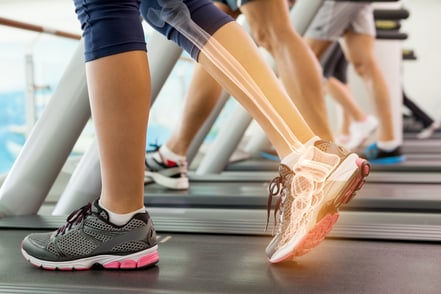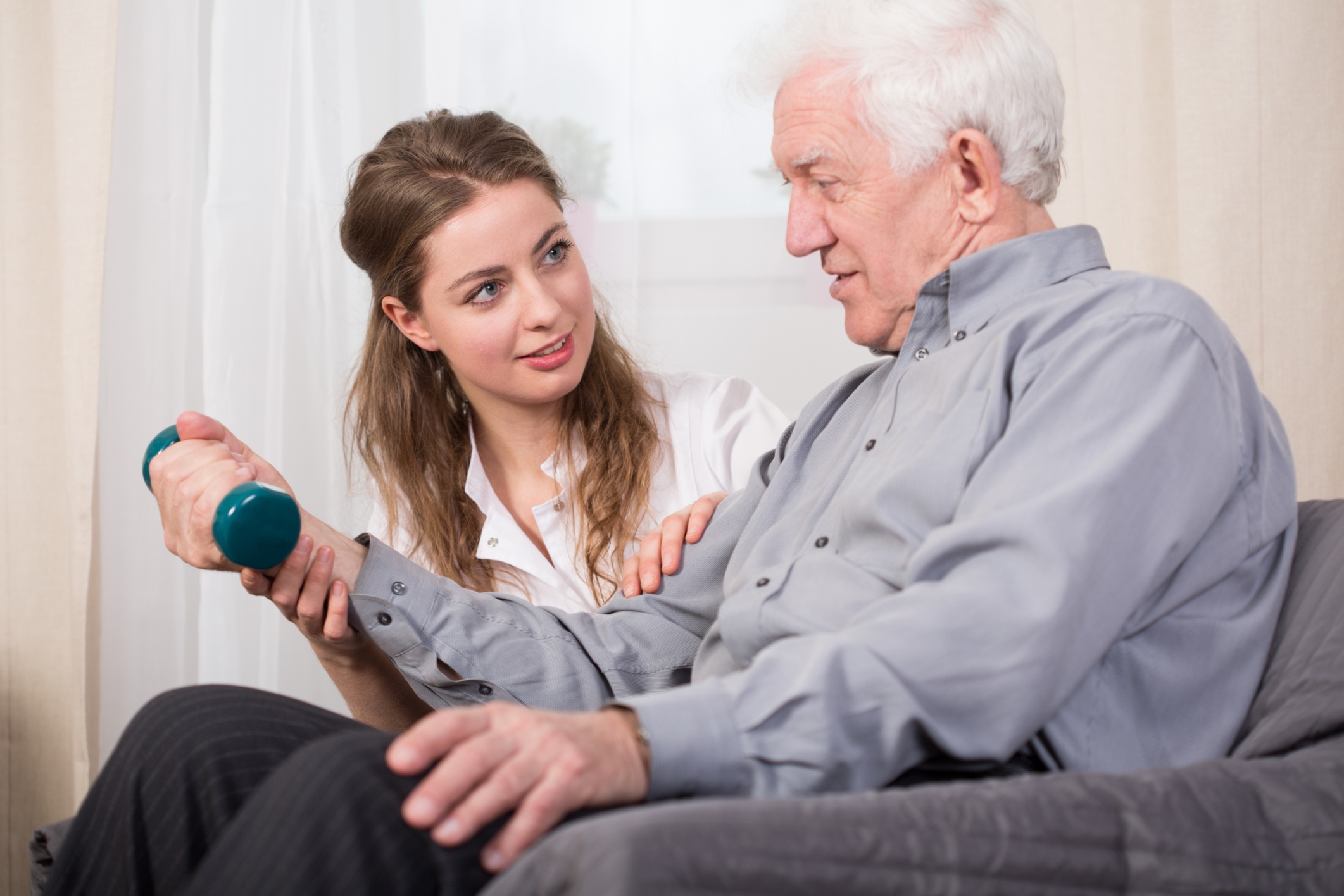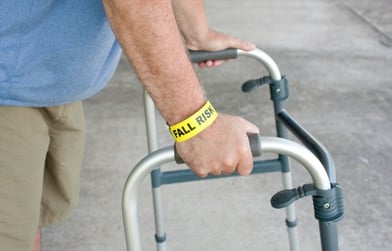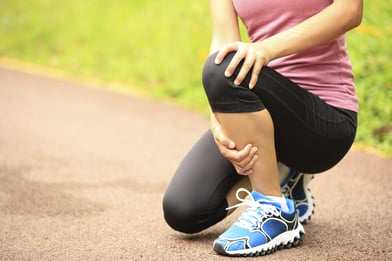 Regardless of whether you're new to exercise or you've been sweating it out for years, there's a good chance you've experienced the sensation of one or both of your feet going numb during a workout. For me, it's most likely to happen when I'm on an elliptical machine in the fitness center, but it's happened when I was out on a run, too. And "Why do your feet go numb during workouts?" is certainly one of the more commonly asked questions posed by our corporate fitness members. This phenomenon is common (and annoying), but it's probably not a life-threatening medical condition. There are a few things you can try to get the sensation to go away for good.
Regardless of whether you're new to exercise or you've been sweating it out for years, there's a good chance you've experienced the sensation of one or both of your feet going numb during a workout. For me, it's most likely to happen when I'm on an elliptical machine in the fitness center, but it's happened when I was out on a run, too. And "Why do your feet go numb during workouts?" is certainly one of the more commonly asked questions posed by our corporate fitness members. This phenomenon is common (and annoying), but it's probably not a life-threatening medical condition. There are a few things you can try to get the sensation to go away for good.
Check your routine. If you find that you frequently experience numbness during a specific activity, try changing up your routine. Maybe that particular piece of equipment or class just isn't the right fit for your body. Who knows, it might be that you just need a break, and taking a little time off can allow you to come back refreshed and ready for a new start.
Check your laces. You may find that a simple adjustment in how tightly you lace your shoes can help. Resist the urge to snug-up the laces for a tight fit, and instead give your foot a little breathing room. Feet sometimes swell during exercise, and if you lace up tightly before you start sweating, you don't leave much room for your foot to spread.
Check your shoes. Consider the width (brand) of your shoe. A medium-width shoe is not the same across brands, and the same make/model of shoe has a different width for men and women. Men's shoes tend to have a wider toe box than women's shoes. So ladies, if you don't need a wide width, but your women's joggers aren't cutting it, try the men's version of the same shoe for a more comfortable fit. If you haven't been professionally fitted for shoes, it may be worth that investment.
[Related Content: How to find the right shoe]
Check your placement. On an elliptical or a bike, where the tendency is to keep your feet in the same position throughout the workout, think about making slight movements throughout the ride/roll. Subtly shifting how you place pressure on your feet over the span of a 20–40-minute session can help minimize numbness in the feet.
Check your symptoms. If you can use one of the recommendations above and the numbness goes away, no worries. If you find, however, that the numbness persists through your day, always occurs in the same place on your foot, or is so severe that you have to discontinue your workouts, it may be time to see your doctor. You may be dealing with a pinched-nerve injury that will need more than the suggestions above to remedy.




 Obesity is an epidemic in our society today. Those who are obese have greater risk of diabetes, coronary artery disease, stroke, and arthritis.
Obesity is an epidemic in our society today. Those who are obese have greater risk of diabetes, coronary artery disease, stroke, and arthritis.
 During my days as a track athlete, I came to know shins splints a little too well. The constant running and pounding will undoubtedly bring about some discomfort in your lower legs. But I am here to tell you don’t panic! There are ways to fight back against the pain you are feeling and get back to running that doesn’t require you to completely take time off. Follow these tips to understand how to sooth your shins and get back on track!
During my days as a track athlete, I came to know shins splints a little too well. The constant running and pounding will undoubtedly bring about some discomfort in your lower legs. But I am here to tell you don’t panic! There are ways to fight back against the pain you are feeling and get back to running that doesn’t require you to completely take time off. Follow these tips to understand how to sooth your shins and get back on track!
 We have all heard the phrase “quality over quantity,” and most of us have even directed this adage at someone else. But do we really believe it? And if we do, why is every gym and fitness center in the country filled with people sacrificing form for a few additional reps and pounds?
We have all heard the phrase “quality over quantity,” and most of us have even directed this adage at someone else. But do we really believe it? And if we do, why is every gym and fitness center in the country filled with people sacrificing form for a few additional reps and pounds? Your joints play an important role in all of life’s activities. They connect bone to bone, which allows your body to move during everything from sports and exercise to everyday functions such as playing with kids, lifting groceries, performing yard work, and even sitting at a desk.
Your joints play an important role in all of life’s activities. They connect bone to bone, which allows your body to move during everything from sports and exercise to everyday functions such as playing with kids, lifting groceries, performing yard work, and even sitting at a desk. Fitness fanatics have all been there. You are so excited about working out, living the diehard active life. Who can give up running, aerobics classes, racquetball, and all the other fitness fun? Then you hear it, that voice that says, “This twinge you have had isn’t going anywhere.”
Fitness fanatics have all been there. You are so excited about working out, living the diehard active life. Who can give up running, aerobics classes, racquetball, and all the other fitness fun? Then you hear it, that voice that says, “This twinge you have had isn’t going anywhere.” We’ve seen muscle cramps strike athletes on the basketball court, football field, and during running events, and many of us have experienced them first-hand. This sharp, sudden pain can be so fierce that it is temporarily crippling. A cramp may also be physically manifested by a hard lump under the skin.
We’ve seen muscle cramps strike athletes on the basketball court, football field, and during running events, and many of us have experienced them first-hand. This sharp, sudden pain can be so fierce that it is temporarily crippling. A cramp may also be physically manifested by a hard lump under the skin. There are many reasons for seeking the help of a personal trainer. Corporate health and fitness specialists can introduce you to an exercise routine, help you break through a rut, or give you the extra boosts of knowledge, motivation, and accountability that you need to achieve the next level in your fitness. But how do you pick a trainer?
There are many reasons for seeking the help of a personal trainer. Corporate health and fitness specialists can introduce you to an exercise routine, help you break through a rut, or give you the extra boosts of knowledge, motivation, and accountability that you need to achieve the next level in your fitness. But how do you pick a trainer? Corporate fitness professionals as well as other health and safety organizations in the workplace stress the importance of preventing injuries, not just curing them. The recent strategy discussed among many worksites today is to engage employees in stretching and proper ergonomics training before an injury occurs.
Corporate fitness professionals as well as other health and safety organizations in the workplace stress the importance of preventing injuries, not just curing them. The recent strategy discussed among many worksites today is to engage employees in stretching and proper ergonomics training before an injury occurs.